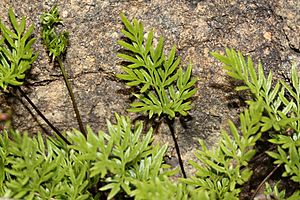Indian's dream facts for kids
Quick facts for kids Indian's dream |
|
|---|---|
 |
|
| Scientific classification | |
| Genus: |
Aspidotis
|
| Species: |
densa
|
| Synonyms | |
|
Cheilanthes siliquosa |
|
Aspidotis densa is a type of fern often called Indian's dream. This small plant grows in many parts of western North America, from British Columbia in Canada down to California and Wyoming in the United States. You can also find it in eastern North America, like in Quebec, Canada.
This fern likes to grow in rocky places. In California, it often lives on rocky mountain slopes that have a special kind of soil called serpentine soil. This soil drains water well but can be moist during certain times of the year.
The leaves of Aspidotis densa grow on long stems called petioles. The leafy part of the plant is usually less than half the total length of the leaf, including the stem. The leaves that help the plant reproduce and the ones that don't might look similar or a little different.
The leafy part of the fern is shaped like a triangle. It has many smaller parts called leaflets, which are divided into smooth, untoothed sections. These sections have special spore-producing structures called sori along their edges. The fern's leaf edges fold over these sori to protect them, forming what looks like a false cover.
Aspidotis densa ferns often start growing in small cracks and open rocky spots. Over time, they can spread and fill up every tiny space, creating large groups of ferns on the rocks. Some of these ferns might have two different kinds of leaves: shorter, wider leaves that don't produce spores, and taller, narrower leaves that do. The spore-producing leaves grow on long, thin stems.
This fern usually grows about 2 to 4 inches (5-10 cm) tall and can spread out 6 to 12 inches (15-30 cm) wide.
How This Fern Helps Scientists
Aspidotis densa is a useful plant for scientists because it can show where certain types of rocks are hidden underground. These rocks are called ultramafic rocks. When these rocks are present, the soil they create is often serpentine soil.
In places like the Klamath Mountains in northern California and southwest Oregon, where these rocks are found in patches, Aspidotis densa helps scientists see them. Areas with serpentine soil often have fewer plants or open forests, while nearby areas with different soils have thicker forests. This fern helps mark those special soil areas.
Images for kids



